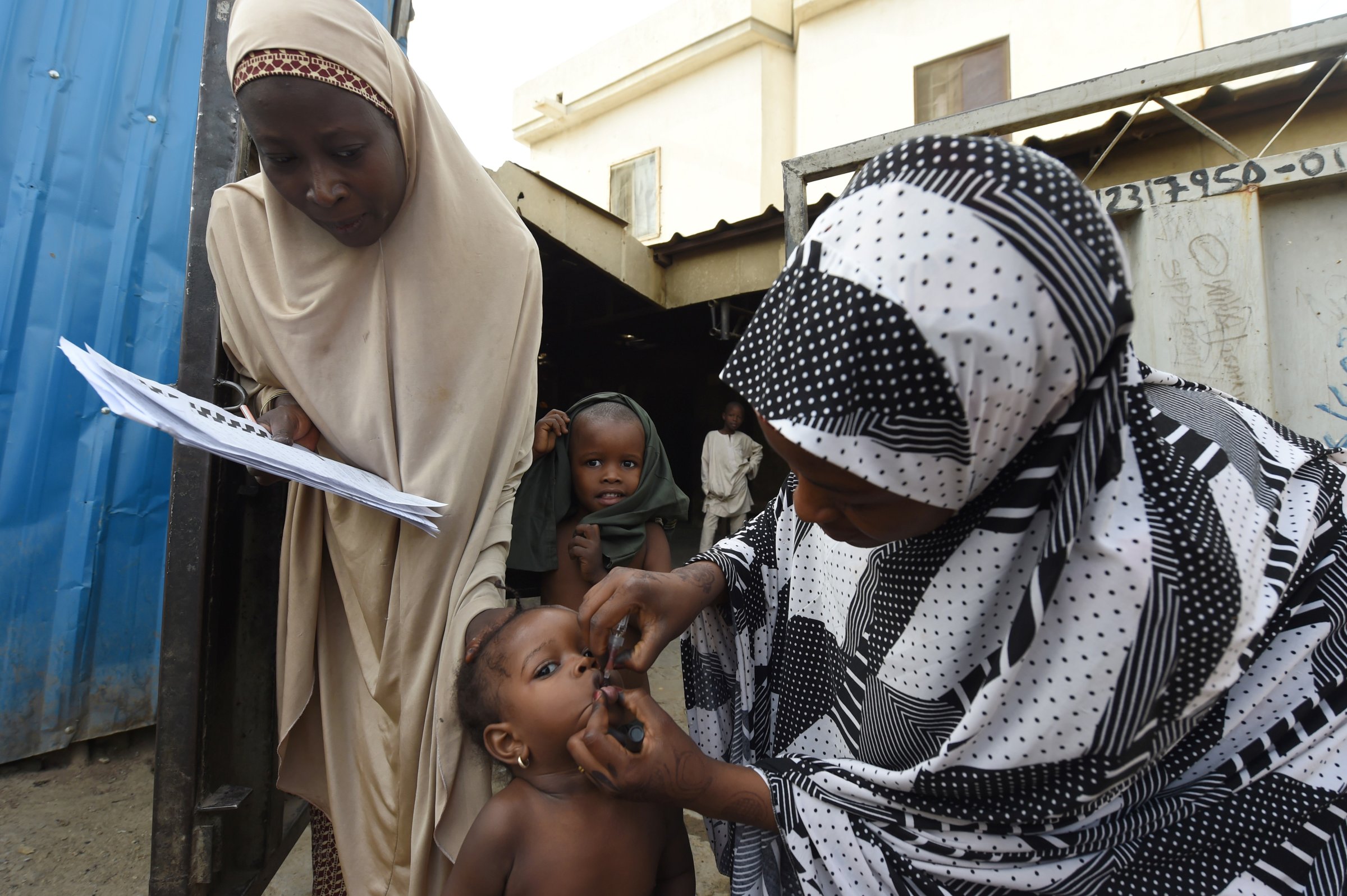
The 50 million doses of polio vaccine stored in laboratory refrigerators all over Nigeria had a big weekend planned for them. If things had gone as intended, on Saturday morning, May 5, all of the little vials would have been trucked, flown, biked, walked around all 36 states of the nation – to be delivered to every single one of the 49,882,036 known Nigerian children under 5 years old. But, as things developed, an outbreak of circulating virus in one region of the country upended those plans for routine immunization, replacing them for now with a crisis response in the affected area. The 50 million doses will instead remain on ice until some time late in June.
That is the start-stop way polio surveillance and immunization works—indeed, is supposed to work. And that’s what has allowed Nigeria to go a full 20 months without a single case of paralytic polio. If the country can make it to three years, plus a few extra months as an epidemiological cushion, it will be certified polio-free, which will also mean that the entire continent of Africa is clear of the disease. That will leave Afghanistan and Pakistan as the only nations on Earth where polio is endemic.
“Certification will be an achievement,” says Dr. Tunji Funsho, a former cardiologist who is now the chair of Rotary International’s Polio-Plus Committee in Nigeria. ”But we’re not in a hurry for that. We’re in a hurry to make sure no child is paralyzed.”
Dr. Funsho would have been one of the ranking officials overseeing this weekend’s planned National Immunization Day (NID), which actually would have spanned four days. NIDs are held twice a year in Nigeria, always from Saturday to Wednesday, to help ensure that field workers have two days to visit families when children are home from school. In addition to the semi-annual NIDs, a sub-NID covering nearly 23 million children is held annually in 13 northern states, which are considered high-risk areas.
The current NID was suspended when routine surveillance of sewage detected traces of live poliovirus in the northern states of Jigawa, Sokoto and Gombe, meaning somewhere in those states at least a few children were carrying the virus — perhaps asymptomatically. It had already passed through their bodies and into the environment. Bauchi state, which lies between Jigawa and Gombe, was also likely contaminated.
“When the geneticists sequenced the virus from Jigawa and Gombe they found they were identical,” says Dr. Mohammed Soghair, UNICEF’s polio field coordinator in Nigeria. “Somebody traveled from one state and shed the virus in the other, and that means it could have been shed in Bauchi too.”
In response, vaccine teams scrambled to the affected states to administer 2.4 million vaccine doses, hoping to cauterize the epidemiological wound before any cases of actual paralysis could turn up. Only when that situation is stabilized will the NID get underway.
In some ways, the weekend’s developments in Nigeria capture the devilishly tricky business of polio eradication overall. There are two types of vaccine used to prevent the disease: the oral polio vaccine (OPV) and the injected polio vaccine (IPV). OPV is easier and less expensive to administer and so that’s the kind that is used in mass-scale immunizations. The problem is, OPV uses a live, weakened form of the poliovirus to confer immunity, and on extremely rare occasions, that virus can mutate and actually cause the disease. The IPV, which is preferred in the developed world for routine childhood immunizations, uses a killed virus.
The viral samples found in the affected northern states were this vaccine-derived form of the virus—specifically Type 2. Originally, there were three types of wild poliovirus. Types 2 and 3 have been vaccinated into extinction; Type 1 remains at large. The vaccines used in NIDs include protection against both 1 and 3—since 3 was wiped out only recently. Vaccinations against Type 2 were discontinued in 2016, which made it vexing that it was that type that turned up in the northern-state sewage.
“The vaccines might simply have been discarded when they were no longer needed,” says Dr. Funsho. “Even when a vial looks empty, there can be some traces of virus left.”
To prevent this kind of careless contamination, doctors and other caregivers are cautioned to dispose of vaccine leftovers much more carefully. Vials that are returned to labs can be handled and destroyed like any other medical waste. In villages, empty vials are given something akin to the nuclear waste treatment, boiled and then buried five meters, or about 15 feet, underground. The burial site is then covered with a slab of concrete. In Bauchi state, used vials are taken to the local Ashaka Cement Factory and incinerated in an industrial oven.
It says something about Nigeria that so many of its institutions—political, medical, industrial, to say nothing of the volunteer community—are engaged in the eradication campaign. But it says something about the particular cruelty polio too—a disease that steals the happy, kinetic activity that is supposed to define childhood—that it inspires such immovable human resolve. The virus has no mind. Humans have both minds and hearts. The contest, in the end, isn’t even close.
More Must-Reads From TIME
- The 100 Most Influential People of 2024
- The Revolution of Yulia Navalnaya
- 6 Compliments That Land Every Time
- What's the Deal With the Bitcoin Halving?
- If You're Dating Right Now , You're Brave: Column
- The AI That Could Heal a Divided Internet
- Fallout Is a Brilliant Model for the Future of Video Game Adaptations
- Want Weekly Recs on What to Watch, Read, and More? Sign Up for Worth Your Time
Write to Jeffrey Kluger / Abuja at jeffrey.kluger@time.com